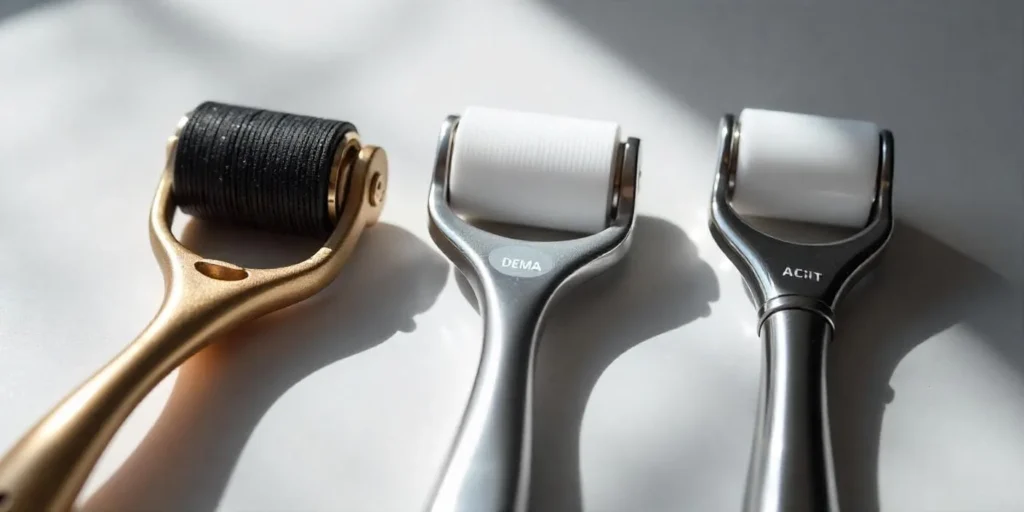Derma rollers are one of the most talked-about skincare tools, known for their ability to improve both skin and hair health. But what exactly do they do, and how effective are they?
This guide covers everything from how derma rollers work to their benefits, different needle sizes, and expected results.
What is a Derma Roller?
A derma roller is a handheld device with a small cylindrical barrel covered in microneedles made of titanium or stainless steel. It is commonly used for microneedling, a process that creates tiny punctures on the skin or scalp to trigger natural healing and rejuvenation.
Derma Roller Needle Sizes & Uses
- 0.2mm – 0.3mm → Improves skincare absorption
- 0.5mm → Reduces fine lines, mild scars & promotes hair growth
- 0.75mm – 1.0mm → Targets deeper wrinkles, noticeable scars & advanced hair loss
- 1.5mm+ → For professional use only (severe scarring & stretch marks)
By creating controlled micro-injuries, derma rollers stimulate collagen and elastin production, essential for maintaining firm, youthful skin and healthy hair follicles. natural healing mechanisms, unlocking numerous potential benefits.
How Do Derma Rollers Work?

Derma rollers work by creating controlled micro-injuries in the skin or scalp using tiny needles. These micro-injuries stimulate the body’s natural healing process, triggering collagen and elastin production in the skin or activating dormant hair follicles on the scalp. This leads to smoother skin, reduced wrinkles, and improved hair growth over time.
When used correctly and consistently, derma rollers can enhance the effectiveness of skincare products, promote cell regeneration, and contribute to firmer, healthier skin and stronger hair. However, results depend on factors like needle size, frequency of use, and individual skin response.
For Skin Rejuvenation
Rolling microneedles across the skin:
✔ Boosts collagen & elastin → Firmer, smoother skin
✔ Improves skin texture → Reduces fine lines, wrinkles & acne scars
✔ Enhances product absorption → Skincare ingredients penetrate deeper
For Hair Growth
Using a derma roller on the scalp:
✔ Increases blood flow → Delivers nutrients to hair follicles
✔ Activates stem cells → Encourages hair regrowth
✔ Stimulates growth factors → Strengthens hair & reduces thinning
This technique is widely used for skin rejuvenation and hair loss treatment, with studies supporting its effectiveness in promoting hair growth and collagen production.
The Role of Micro-Injuries
When derma roller microneedles create tiny punctures in the skin, the body perceives them as minor wounds, triggering a natural healing response. This process stimulates collagen and elastin production, two essential proteins responsible for keeping skin firm, elastic, and youthful. As a result, regular use can lead to:
✔ Smoother skin texture
✔ Reduction in scars and wrinkles
✔ A firmer, more youthful complexion
Impact on the Scalp and Hair Follicles
On the scalp, derma rolling promotes hair growth by stimulating various biological mechanisms:
✔ Improved Blood Flow – Micro-injuries enhance circulation, ensuring better nutrient and oxygen delivery to hair follicles.
✔ Stem Cell Activation – The process may awaken dormant stem cells in the scalp, encouraging hair regrowth.
✔ Growth Factor Stimulation – Derma rolling can increase growth factor production, which is essential for follicle health and the hair cycle.
These effects create an ideal environment for hair regeneration. While research is ongoing, many users report improved hair thickness and density, making derma rolling a promising option for both skin rejuvenation and hair restoration.
How Long Does It Take to See Results?
Results vary based on needle size, consistency, and individual factors like skin type and hair condition. However, here’s a general timeline:
- 4-6 Weeks → Subtle improvements in skin texture, mild hair thickening
- 3-6 Months → Noticeable reduction in acne scars, wrinkles & significant hair regrowth
- 6-12 Months → Full results in collagen production & long-term scalp recovery
⚠️ Consistency is key—skipping treatments or improper technique can slow progress.

Benefits of Derma Rollers
Derma rollers offer multiple benefits for both skin and hair, making them a valuable tool in beauty routines. Here’s how they can help:
Benefits for Skin
Using a derma roller can lead to noticeable improvements in skin texture and appearance:
✔ Reduces Acne Scars – Stimulates collagen production, which helps smooth out acne scars over time.
✔ Minimizes Fine Lines & Wrinkles – Increases collagen and elastin, plumping the skin and reducing signs of aging.
✔ Improves Skin Tone & Texture – Helps even out pigmentation, reduce dark spots, and enhance overall skin radiance.
✔ Shrinks Enlarged Pores – Regular use can minimize the appearance of large pores, leading to a smoother complexion.
✔ Enhances Product Absorption – Creates tiny channels in the skin, allowing skincare ingredients to penetrate deeper and work more effectively.
Benefits for Hair
When used on the scalp, derma rollers can support hair growth and overall hair health:
✔ Stimulates Hair Growth – Improves blood circulation and increases the delivery of nutrients to the hair follicles.
✔ Strengthens Hair Roots – Helps reinforce existing hair, reducing shedding and breakage.
✔ Enhances Scalp Health – Boosts the absorption of hair care products, improving their effectiveness.
✔ Reduces Thinning & Hair Loss – Reactivates dormant follicles and supports new hair growth.
By consistently using a derma roller with the right technique, you can achieve healthier skin and stronger hair over time.
How to Use a Derma Roller
To achieve the best results and avoid side effects, follow these step-by-step guides for both facial and scalp treatments.

Using a Derma Roller on the Face
- Cleanse Your Skin – Wash your face with a gentle cleanser to remove dirt, oil, and makeup.
- Disinfect the Roller – Soak it in 70% or higher isopropyl alcohol for 5-10 minutes.
- Apply Numbing Cream (Optional) – If using needles longer than 0.5mm, numbing cream can help minimize discomfort.
- Start Rolling – Divide your face into sections and roll in each direction (vertical, horizontal, and diagonal) 2-4 times using light pressure.
- Apply a Serum – Use a hydrating serum like hyaluronic acid or peptides to enhance skin recovery.
- Clean the Roller – Wash with soap and water, disinfect again, and store properly.
Using a Derma Rollers on the Scalp
- Wash Your Scalp – Cleanse with a mild shampoo and ensure your scalp is dry.
- Sanitize the Roller – Disinfect it before use.
- Section Your Hair – Part hair to expose the areas needing treatment.
- Roll in Multiple Directions – Roll over thinning areas 5-10 times in vertical, horizontal, and diagonal patterns.
- Apply a Hair Serum (Optional) – Minoxidil or other growth serums can be applied for enhanced results.
- Clean & Store the Roller – Follow proper hygiene steps to maintain the tool.
Pro Tip: Use a derma roller 2-3 times per week for optimal results, and always follow with hydrating and nourishing treatments.
Potential Side Effects and Risks
While derma rolling is generally safe, improper use can lead to unwanted side effects. Here’s what to watch out for:
Common Side Effects
⚠ Redness & Irritation – Mild redness is normal and should subside within a few hours.
⚠ Increased Sensitivity – The treated area may feel more sensitive post-treatment.
⚠ Dryness & Flaking – Skin may peel as part of the renewal process.
⚠ Minor Bleeding or Bruising – This can occur with longer needles or excessive pressure.
Infection Risks & Precautions
🔹 Always disinfect the roller before and after use.
🔹 Never share your derma roller with others.
🔹 Avoid rolling over active acne, open wounds, or irritated skin.
🔹 Replace your roller regularly to prevent dull needles and bacterial buildup.
When to Avoid Derma Rolling
🚫 Active Acne or Breakouts – Can spread bacteria and worsen inflammation.
🚫 Skin Conditions (Eczema, Psoriasis, Rosacea) – May aggravate sensitive skin.
🚫 Open Cuts or Wounds – Increases the risk of infection.
🚫 Keloid or Hypertrophic Scars – Those prone to excessive scarring should consult a doctor first.
Consult a dermatologist if you have pre-existing skin conditions or concerns before starting derma rolling.
Choosing the Right Derma Roller
Selecting the right needle size is crucial for safety and effectiveness. Here’s a quick guide:
| Needle Size | Best For |
|---|---|
| 0.2mm – 0.3mm | Enhancing product absorption |
| 0.5mm | Improving skin texture & mild wrinkles |
| 0.75mm – 1.0mm | Deeper wrinkles, acne scars, hair regrowth |
| 1.5mm+ | Professional use for severe scars & stretch marks |
🔹 For Skin: Choose 0.5mm – 1.0mm for anti-aging and scar treatments.
🔹 For Hair: Use 0.5mm – 1.0mm to stimulate follicles and promote regrowth.
Always opt for high-quality titanium or surgical-grade stainless steel needles to ensure durability and hygiene.
Conclusion
Derma rollers offer a scientifically backed way to improve skin health and promote hair growth when used correctly. Their ability to stimulate collagen and enhance product absorption makes them a powerful addition to any beauty routine.
✔ For Skin: They can reduce scars, fine lines, and hyperpigmentation.
✔ For Hair: They improve blood circulation and support stronger, thicker hair growth.
However, proper technique, hygiene, and consistency are key to achieving results while avoiding side effects. Always consult a professional if you have concerns about how derma rolling fits into your personal skincare or haircare routine.
Would you try derma rolling for skin or hair? Let us know your thoughts!
Frequently Asked Questions (FAQs) About Derma Rollers
1. Do derma rollers really work, or is it just a trend?
Yes, derma rollers are backed by science, not just hype. By creating tiny micro-injuries, they trigger collagen and elastin production, helping to smooth out fine lines, acne scars, and uneven skin texture. They can also boost hair growth when used on the scalp. However, results depend on consistent use, the right needle size, and proper aftercare.
2. Can derma rolling harm my skin if done incorrectly?
Absolutely. If used too aggressively, on unclean skin, or with a contaminated roller, derma rolling can cause irritation, breakouts, and even infections. Using excessive pressure may also lead to unnecessary skin damage. Always disinfect your roller before and after each use, choose the correct needle size, and avoid rolling over inflamed or broken skin.
3. Does derma rolling hurt?
Pain levels depend on the needle size and personal sensitivity. Small needles (0.2mm–0.5mm) cause little to no discomfort, while longer ones (0.75mm–1.5mm) may feel more intense. If using larger needles, applying a numbing cream beforehand can make the process more comfortable.
4. How frequently should I use a derma roller?
Usage depends on the needle length:
- 0.2mm – 0.3mm: Can be used every other day for enhanced product absorption.
- 0.5mm: Ideal for skin texture improvement, used 1–2 times a week.
- 0.75mm – 1.0mm: Best for deeper scars and wrinkles; use once every two weeks.
- 1.5mm+: Should only be used once a month, preferably under professional supervision.
5. Is it safe to use a derma roller with retinol or vitamin C?
Not immediately after rolling. Since derma rolling temporarily increases skin sensitivity, applying strong actives like retinol or vitamin C right after can cause burning, redness, and irritation. Instead, use soothing serums like hyaluronic acid or peptides post-treatment. Retinol and vitamin C can be reintroduced the next day for best results.
Can I derma roll if I have acne, rosacea, or sensitive skin?
No, it’s not recommended. Rolling over active acne can spread bacteria and worsen breakouts, while those with rosacea or highly reactive skin may experience increased irritation. Wait until your skin is clear before incorporating derma rolling into your routine.






